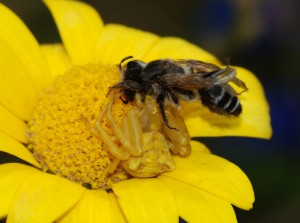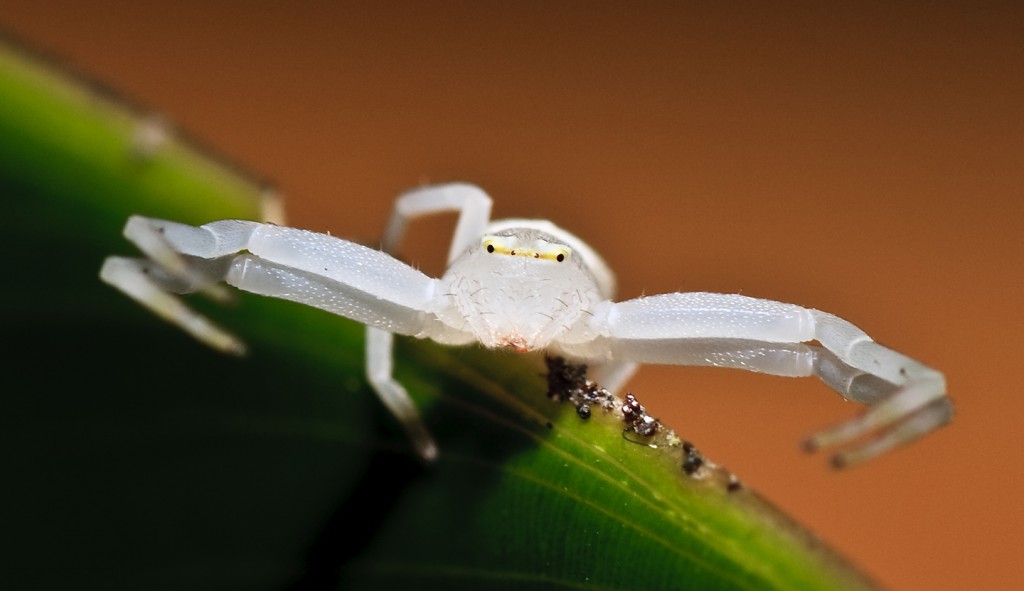by Kristen Minogue

The goldenrod crab spider (Misumena vatia) blends in almost perfectly with the yellow chamomile flower. (Alvegaspar)
There’s a reason cobwebs make popular Halloween decorations. Spiders rival with snakes, birds and clowns for the most feared creatures in the animal kingdom. But some of nature’s creepiest arachnids don’t build webs at all. They ambush their prey in much more beguiling settings. Like flowers.
That’s a favorite haunt of the crab spider, one of several groups of webless spiders that hunt, instead of trap, their food. The name comes from their four long front legs, which stretch out like claws, and their crab-like method of walking—they’re better at moving sideways and backwards than forwards. But their strategy for capturing prey has earned them another common name: the ambush spiders.
Crab spiders often hide between flower petals waiting for an unsuspecting bee or butterfly to approach. Some species, like female goldenrod crab spiders, change colors between yellow and white for better camouflage, though the transformation can take days. They can afford to be patient. The spiders’ low metabolism allows them to go months without a meal.
When they strike, venom from the spider’s fangs quickly paralyzes the victim. Because they lack teeth (aside from their hollow fangs), crab spiders cannot eat their prey. Instead, the spider’s digestive juices liquefy their insides, which the spiders drink through their jaws, called chelicerae.
Some spiders will even let carnivorous plants do their killing for them. The red crab spider makes its home in the pitcher plant, a deadly trap to ants and other insects. Strands of silk enable the spider to crawl around the pitcher walls without falling in. When a less fortunate insect falls inside and drowns, the spider fishes it out of the water, drinks its internal organs and leaves the rest for the plant to digest. The plant gains little, if anything, from the arrangement. But for the crab spider, it means bigger meals—many of the insects trapped by the pitcher plant would be too large for the spider to confront on its own.
VIDEO: Red crab spider captures and kills an ant in a pitcher plant

The crab spider Misumenops nepenthicola spends its entire life in the insect-eating pitcher plant for its food supply. (Greh Fox)
And at least one crab spider in Australia is known to commit matricide. Babies of the social crab spider, Diaea ergandros, will eat their own mother when food becomes scarce. For roughly the first four months of their lives, the mother spider hunts to feed her brood. But as the young spiders become larger and more aggressive, her quarry isn’t enough to sustain them. At that point, the mother allows her offspring to eat her instead. Starting with her legs and arms, they move on to the eyes and eventually consume her entire body. It’s a sacrifice researchers think evolved to prevent sibling cannibalism. The baby spiders can survive five to six weeks eating their mother before striking out on their own.
Life without a web has a few benefits. A spider in a web relies on vibrations to detect when an insect has flown into its trap, so its eyesight is often poorer than its hunting cousins. A web also makes an easy target for predators. And while web spiders don’t need to spend as much energy searching for food, catching it depends largely on luck. Crab spiders—and even moreso the wolf, fishing and jumping spiders—can make some of their own luck.
A flower that hides a crab spider means certain death for small insects, and some large ones. But there’s some relief for arachnophobes: While a crab spider’s bite may cause minor pain for humans, their venom is harmless to any who aren’t allergic to them.
Photo of Misumenops nepenthicola spider used with permission via Creative Commons License here.

